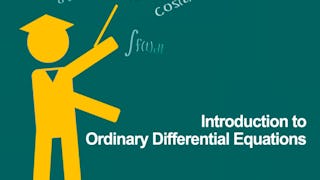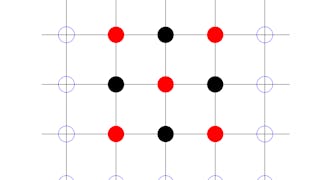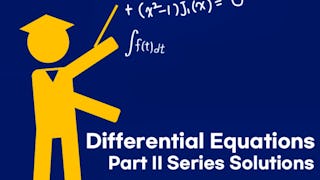Ce cours porte sur les équations différentielles et couvre à la fois la théorie et les applications. Les cinq premières semaines sont consacrées aux équations différentielles ordinaires, tandis que la sixième semaine est une introduction aux équations différentielles partielles. Le cours comprend 56 vidéos de cours concises, avec quelques problèmes à résoudre après chaque cours. Après chaque sujet majeur, il y a un petit quiz d'entraînement. A la fin de chaque semaine, il y a un quiz évalué. Les solutions aux problèmes et aux quiz d'entraînement se trouvent dans les notes de cours fournies par l'enseignant.



Equations différentielles pour ingénieurs
Ce cours fait partie de Spécialisation Mathématiques pour ingénieurs

Instructeur : Jeffrey R. Chasnov
Enseignant de premier plan
68 155 déjà inscrits
Inclus avec 
(2,139 avis)
Expérience recommandée
Ce que vous apprendrez
Equations différentielles du premier ordre
Equations différentielles du second ordre
La transformée de Laplace et les méthodes de résolution des séries
Systèmes d'équations différentielles et d'équations aux dérivées partielles
Compétences que vous acquerrez
- Catégorie : Calculs
- Catégorie : Mathématiques
- Catégorie : Résolution de problèmes
- Catégorie : Esprit Critique
- Catégorie : Algèbre linéaire
- Catégorie : Théorie et analyse mathématiques
Détails à connaître

Ajouter à votre profil LinkedIn
28 quizzes, 3 devoirs
Découvrez comment les employés des entreprises prestigieuses maîtrisent des compétences recherchées

Élaborez votre expertise du sujet
- Apprenez de nouveaux concepts auprès d'experts du secteur
- Acquérez une compréhension de base d'un sujet ou d'un outil
- Développez des compétences professionnelles avec des projets pratiques
- Obtenez un certificat professionnel partageable


Obtenez un certificat professionnel
Ajoutez cette qualification à votre profil LinkedIn ou à votre CV
Partagez-le sur les réseaux sociaux et dans votre évaluation de performance

Il y a 6 modules dans ce cours
Une équation différentielle est une équation pour une fonction avec une ou plusieurs de ses dérivées. Nous présentons les différents types d'équations différentielles et la manière de les classer. Nous discutons ensuite de la méthode d'Euler pour résoudre numériquement une équation différentielle ordinaire (EDO) du premier ordre. Nous apprenons les méthodes analytiques pour résoudre les EDO séparables et linéaires du premier ordre, avec une explication de la théorie suivie de solutions illustratives de quelques EDO simples. Enfin, nous explorons trois exemples concrets d'EDO du premier ordre : les intérêts composés, la vitesse terminale d'une masse en chute libre et le circuit électrique résistance-condensateur.
Inclus
14 vidéos14 lectures6 quizzes1 devoir
Nous généralisons la méthode numérique d'Euler à une EDO du second ordre. Nous développons ensuite deux concepts théoriques utilisés pour les équations linéaires : le principe de superposition et le Wronskien. En utilisant ces concepts, nous pouvons trouver des solutions analytiques à une EDO homogène du second ordre à coefficients constants. Nous utilisons un ansatz exponentiel et transformons l'EDO à coefficients constants en une équation polynomiale du second ordre appelée équation caractéristique de l'EDO. L'équation caractéristique peut avoir des racines réelles ou complexes et nous apprenons les méthodes de résolution pour les différents cas.
Inclus
11 vidéos11 lectures4 quizzes1 plugin
Nous ajoutons maintenant un terme inhomogène à l'EDO à coefficient constant. Le terme inhomogène peut être une exponentielle, un sinus ou un cosinus, ou un polynôme. Nous étudions également le phénomène de résonance, lorsque la fréquence de forçage est égale à la fréquence naturelle de l'oscillateur. Enfin, nous découvrons trois applications importantes : le circuit électrique RLC, une masse sur un ressort et le pendule.
Inclus
12 vidéos9 lectures5 quizzes
Nous présentons deux nouvelles méthodes analytiques de résolution des EDO linéaires. La première est la méthode de la transformée de Laplace, qui est utilisée pour résoudre l'EDO à coefficient constant avec un terme inhomogène discontinu ou impulsif. La transformée de Laplace est un bon véhicule en général pour introduire des techniques sophistiquées de transformation intégrale dans un contexte facilement compréhensible. Nous introduisons également la solution d'une EDO linéaire par une solution en série. Bien que nous ne l'approfondissions pas ici, une introduction à cette technique peut être utile aux étudiants qui la rencontreront à nouveau dans des cours plus avancés.
Inclus
11 vidéos10 lectures4 quizzes1 devoir
Nous apprenons à résoudre un système couplé d'équations différentielles homogènes du premier ordre à coefficients constants. Ce système d'EDO peut être écrit sous forme de matrice, et nous apprenons à convertir ces équations en un problème standard de valeurs propres de l'algèbre matricielle. Les solutions bidimensionnelles sont ensuite visualisées à l'aide de portraits de phase. Nous apprenons ensuite une application importante des oscillateurs harmoniques couplés et le calcul des modes normaux. Les modes normaux sont les mouvements pour lesquels les masses individuelles qui composent le système oscillent à la même fréquence. Nous appliquons ensuite la théorie pour résoudre un système de deux oscillateurs harmoniques couplés et utilisons les modes normaux pour analyser le mouvement du système.
Inclus
13 vidéos10 lectures4 quizzes1 devoir
Pour apprendre à résoudre une équation différentielle partielle (EDP), nous commençons par définir une série de Fourier. Nous dérivons ensuite l'équation de diffusion unidimensionnelle, qui est une EDP décrivant la diffusion d'un colorant dans un tuyau. Nous procédons ensuite à la résolution de cette EDP à l'aide de la méthode de séparation des variables. Cela implique de diviser l'EDP en deux équations différentielles ordinaires (EDO), qui peuvent ensuite être résolues à l'aide des techniques standard de résolution des EDO. Nous utilisons ensuite les solutions de ces deux EDO et notre définition d'une série de Fourier pour retrouver la solution de l'EDP d'origine.
Inclus
11 vidéos11 lectures5 quizzes
Instructeur

Enseignant de premier plan
Recommandé si vous êtes intéressé(e) par Mathématiques et logique


Korea Advanced Institute of Science and Technology(KAIST)


The Hong Kong University of Science and Technology


Korea Advanced Institute of Science and Technology(KAIST)


Korea Advanced Institute of Science and Technology(KAIST)
Pour quelles raisons les étudiants sur Coursera nous choisissent-ils pour leur carrière ?




Avis des étudiants
2 139 avis
- 5 stars
88,46 %
- 4 stars
9,85 %
- 3 stars
1,26 %
- 2 stars
0,04 %
- 1 star
0,37 %
Affichage de 3 sur 2139
Révisé le 28 juil. 2023
Great course with crystal clear explanations and derivations. Although the topic of differential equations is a refresher for me, I found the course very interesting and engaging. Thank you!
Révisé le 11 avr. 2021
Excellent course taught by an excellent professor, Dr. Chasnov.Just the right content, just the right pace and practice problems and quiz complemented the course material very well.
Révisé le 27 août 2020
I think this course is very suitable for any curious mind. You can learn very important and necessary concepts with this course.The courses taught by Professor Dr. Chasnov are excellent.


Ouvrez de nouvelles portes avec Coursera Plus
Accès illimité à 10,000+ cours de niveau international, projets pratiques et programmes de certification prêts à l'emploi - tous inclus dans votre abonnement.

Faites progresser votre carrière avec un diplôme en ligne
Obtenez un diplôme auprès d’universités de renommée mondiale - 100 % en ligne

Rejoignez plus de 3 400 entreprises mondiales qui ont choisi Coursera pour les affaires
Améliorez les compétences de vos employés pour exceller dans l’économie numérique
Foire Aux Questions
L'accès aux cours et aux devoirs dépend de votre type d'inscription. Si vous suivez un cours en mode audit, vous pourrez consulter gratuitement la plupart des supports de cours. Pour accéder aux devoirs notés et obtenir un certificat, vous devrez acheter l'expérience de certificat, pendant ou après votre audit. Si vous ne voyez pas l'option d'audit :
Il se peut que le cours ne propose pas d'option d'audit. Vous pouvez essayer un essai gratuit ou demander une aide financière.
Le cours peut proposer l'option "Cours complet, pas de certificat" à la place. Cette option vous permet de consulter tous les supports de cours, de soumettre les évaluations requises et d'obtenir une note finale. Cela signifie également que vous ne pourrez pas acheter un certificat d'expérience.
Lorsque vous vous inscrivez au cours, vous avez accès à tous les cours de la Specializations, et vous obtenez un certificat lorsque vous terminez le travail. Votre certificat électronique sera ajouté à votre page de réalisations - de là, vous pouvez imprimer votre certificat ou l'ajouter à votre profil LinkedIn. Si vous souhaitez uniquement lire et visualiser le contenu du cours, vous pouvez auditer le cours gratuitement.
Si vous vous êtes abonné, vous bénéficiez d'une période d'essai gratuite de 7 jours pendant laquelle vous pouvez annuler votre abonnement sans pénalité. Après cette période, nous ne remboursons pas, mais vous pouvez résilier votre abonnement à tout moment. Consultez notre politique de remboursement complète.

